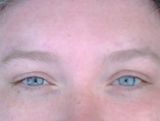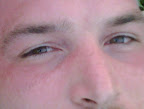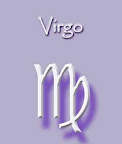
I was made aware that GeoCities is shutting down... so little by little I'll be posting things on here instead of "creating a new webspace" just follow the "Pagan Stuff" to find more things in relation to my beliefs...Altho I request you hold nothing against me... I am only 1 person after all and make no claims to following any one certain path. I do what my heart tells me to and I am still confused on how I perceive alot of things...
On this page you will find various articles, etc dealing with my chosen Goddess, Aine. I hope that you enjoy her company as much as I do.
AINE
Aine is one of the Great Goddesses of Ireland. She is a Moon goddess, a Love goddess who encourages humanlove, and the Fairy Queen of Munster. Aine (pronouced 'aw-ne') rules agriculture, fertility, crops, and animals. She was originally a Sun goddess who could take the form of a Lair Derg, a red mare that no one could outrun. It is possible that Aine and Grainne alternated as goddesses of the waning and waxing solar year, changing place at the solstices.
Aine's father, King Egobagal, is one of the Tuatha de Danann. Also called Aine Marine and Aine of Knockaine, she is associated with Dnoc Aine/Knockainy (Aineis Hill_ in Munster, and with Dun Aine (Dunany Point) in County Louth. People with the surname O'Corra are said to be her descendants.
There are several myths about Aine who some say was a mortal woman who was taken and enchanted by the fae. She possesses a magical ring that can reveal faeries. Aine liked humans and often mated with men, producing faery children. She once made a magickal vow to never sleep with a gray-haired man. Aine kept this vow even after her jealous sister Miluchrach used enchantment to turn her beloved Fionnis hair that color. She used magick to kill Aillil Olom, the King of Munster, when he tried to rape her.
There are several stories about how Aine came to marry Gerald, the Earl of Desmond. Gerald came across her bathing in a river and fell in love with her at first site. He stole her cloak and refused to return it until she agreed to marry him. In another version he found Aine combing her hair beside the river, and used her own cloak to capture her. In yet another version, Aine enchanted the Earl, who them married her.
In any case, they had a son, Geroid Iarla, Earl Fitzgerald, who was called The Magician. Gerald who was under a taboo to never show that he was surprised by anything thier son did, but he broke his taboo by exclaiming loudly when Geroid jumped in and out of a bottle. The Magician then turned into a wild goose, and flew away. Disgusted with her human husband, Aine disappeared into Knock Aine. She is said to dwell there still, in a faery castle. Geroid is said to live beneath a lake, but will return one day to expel all foreigners from Ireland. Others say that Geroid rides forth every seven years, as a phanton upon a spectral white horse that is shod in silver shoes.
Invoke Aine for love spells, fertility, faery magick, abundance, prosperity, punishing sex crimes, keeping magickal vows, revealing faeries, bearing magickal children, and leaving unsuitable mates. The Sun and Moon are her planets, South West is her direction, and Air is her element. The red mare, rabbit, and swam are her sacred animals. Midsummer Eve (Summer solstice) is Aine's main feast day, when she is traditionally worshiped with torchlit processions through the fields at night. The first Friday, Saturday, and Sunday after Lughnassad (August 1) are also her sacred days. Some say that she claims a life at that time.
~!~!~!~!~!~!~!~!~!~!~!~!~!~!~!~!~!~!~!~!~!~!~

The Goddess of a 1000 Names, this Goddess is Celtic Fairy Queen Aine, Goddess of Ireland
AINE OF KNOCAINE: (Pronounced aw-ne); Ireland. Moon Goddess; patroness of crops and cattle. Connected with the Summer Solstice.
One of the best known goddesses of Ireland is Aine, who is exceedingly friendly to men and worshipped for her powers of bestowing fertility, abundance and prosperity. She is said to have mated with several humans, having created a magical fairy/human race. An Irish Earl once stole Aine's cloak while she swam in a river, and would not return it to her until she agreed to marry him.
Their son was known as the Magician, and Aine told the Earl never to be surprised at anything he could do. The Earl could not help himself in showing surprise when his son performed a wonderful superhuman deed, and this set Aine free to return to the fairies.
Her son lives inside Lough Fur in County Limerick, waiting for the time he will expel all foreigners from Ireland. Every seven years he rides around the entire circumference of the lake, and will continue to do so until his horse's silver shoes are worn out.
There are many great fairy queens that are remembered in Irish folk tales. They are known as 'bean righean na brugh', the fairy queen of the palace, and are quite clearly the tutelary goddesses of local tribes. Many are still said to be the guardians of certain Irish clans. Three miles south west of Lough Gur is Cnoc Aine, or Knockainy, the hill of Aine, one of the most important fairy queens of Munster. Also on the shores of the lake is Cnoc Finnine, of the goddess Fennel, the sister of Aine. Many of the sidhe folk have encounters or relationships with mortals.
The Earl of Desmond once saw Aine combing her hair on the bank of a river. He fell in love with her and seizing her cloak made her his wife. The offspring of this union was Aine's enchanted son Geroid Iarla, who lives under the lake awaiting his return to the world of men. Once every seven years he emerges from the water as a phantom riding on a white horse. Aine is revered throughout Ireland.
In Co. Derry locals say she was a mortal woman who was 'taken' by the fairies; the local family O'Corra are said to be descended from Aine. In Co. Louth Aine's stronghold is at Dunany point (Dun Aine).
Every year three days are dedicated to her, the first Friday, Saturday and Sunday after Lammas; it was said that she would claim a life on those days. It is at Cnoc Aine in Co. Limerick where Aine is most well remembered as a great queen. Every year on St. John's Eve (24 June) local people would form a procession around the hill, then carry flaming torches through the fields of ripening crops. Aine herself was seen on many occasions leading the procession.
~!~!~!~!~!~!~!~!~!~!~!~!~!~!~!~!~!~!~!~!~!~
AINE: (pronounced 'aw-ne')
Moon/Sun/Air/Fire/southwest/Summer
(Celtic: Irish) Moon goddess; fairy queen.
Aine is one of the Great Goddesses of Ireland. She is a Moon goddess, a love goddess who encourages human love, and the fairy queen of Munster. Aine rules agriculture, fertility, crops, and cattle. She was originally a sun goddess who could take the form of Lair Derg, a red mare that no one could outrun. It is possible that Aine and Grainne alternated as goddesses of the waning and waxing solar year, changing places at the solstices.
Aine's father, King Egobagal, is one of the Tuatha de Danann. Also called Aine Marina and Aine of Knockaine, she is associated with Cnoc Aine/Knockainy (Aineís Hill) in County Kerry, and with Dun Aine (Dunany Point) in County Louth. People with the surname O'Corra are said to be her descendants.
There are several myths about Aine, who some say was a mortal woman who was taken and enchanted by the fae. She possesses a magical ring that can reveal fairies. Aine liked humans and often mated with men, producing fairy children. She once made a magical vow to never sleep with a gray-haired man. Aine kept this vow even after her jealous sister Miluchrach used enchantment to turn her beloved Fionnís hair that color. She used magic to kill Aillil Olom, the King of Munster, when he tried to rape her.
There are several stories about how Aine came to marry Gerald, the Earl of Desmond. Gerald came across her bathing in a river and fell in love with her at first sight. He stole her cloak and refused to return it until she agreed to marry him. In another version he found Aine combing her hair beside the river, and used her own cloak to capture her. There is even a version where it was Aine who enchanted the Earl, who then married her.
In any case they had a son, Geroid Iarla, Earl Fitzgerald, who was called The Magician. Gerald was under a taboo to never show that he was surpised by anything their son did, but he broke this taboo by exclaiming aloud when Geroid jumped in and out of a bottle. The Magician then turned into a wild goose, and flew away. Disgusted with her human husband, Aine disappeared into Knock Aine. She is said to dwell there still, in a fairy castle. Geroid is said to live beneath a lake, but will return one day to expel all foreigners from Ireland. Others say that Geroid rides forth every seven years, as a phantom upon a spectral white horse that is shod with silver shoes.
Invoke Aine for love spells, fertility, fairy magic, abundance, prosperity, punishing sex crimes, keeping magical vows, revealing fairies, bearing magical children, and leaving unsuitable mates. The red mare, rabbit, and swan are her sacred animals. Midsummer Eve (Summer Solstice) is Aine's main feast day, when she is traditionally worshiped with torchlit processions through the fields at night. The first Friday, Saturday, and Sunday after Lughnasadh (August 1) are also her sacred days. Some say that Aine claims a life at that time.
~!~!~!~!~!~!~!~!~!~!~!~!~!~!~!~!~!~!~!~!~!~
Aine - (AN-yuh) Ireland; a woman of the Leanan Sidhe (Sweetheart of the Sidhe). Some said she was the daughter of Manannan, some said she was the Morrigan herself. There was a stone, Cathair Aine, belonging to her and if anyone sat on the stone, they would be in danger of losing their wits, sit three times and they would lose them forever. Aine was very revengeful, and it was not a safe thing to offend her.
~!~!~!~!~!~!~!~!~!~!~!~!~!~!~!~!~!~!~!~!~!~
Aine of Knockaine - (AN-yuh of knock-AN-yuh) Ireland; moon goddess and patroness of crops and cattle; associated with the Summer Solstice. Also Aine Cliach, and Cnoc Aine.
~!~!~!~!~!~!~!~!~!~!~!~!~!~!~!~!~!~!~!~!~!~
GODDESS AINE (Pronounced aw-ne)
Aine, Goddess of love and fertility, later known as an Irish Fairy Queen. Also known as Moon Goddess; patroness of crops and cattle. Connected with the Summer Solstice. Symbolised by the Meadowsweet herb.
The Celts are known to make offerings to this Goddess of Love during the Summer Solstice when they burn straw and flowers in her honour and ask in return that she may keep evil and ill health from their doors.
A well known goddess of Ireland is Aine, who is exceedingly friendly to men and worshipped for her powers of bestowing fertility, abundance, prosperity and love. She is said to have mated with several humans, having created a magical fairy/human race. An Irish Earl once stole Aine's cloak while she swam in a river, and would not return it to her until she agreed to marry him.
Irish legends depict her son as an archetype of Lancelot in the later Arthurian legends, while Aine herself is the Lady of the Lake.
Her son was known as the Magician, and Aine told the Earl never to be surprised at anything he could do. The Earl was surprised when his son performed a wonderful superhuman deed, and this set Aine free to return to the fairies.
Aine is in several tales strongly associated with the Yew tree which shows her as a Goddess of Life and Death. In all her aspects it is clearly shown that Aine was no deity to offend, for in spite of all her beneficent attributes, if crossed she could have coined the phrase "Hell hath no fury like a woman scorned".





I don't follow a certain path either. I do what I feel is right. I don't know how else to explain it.
ReplyDeleteme neither and i think that's a perfect explanation!
ReplyDeleteI would love some sources :(
ReplyDelete